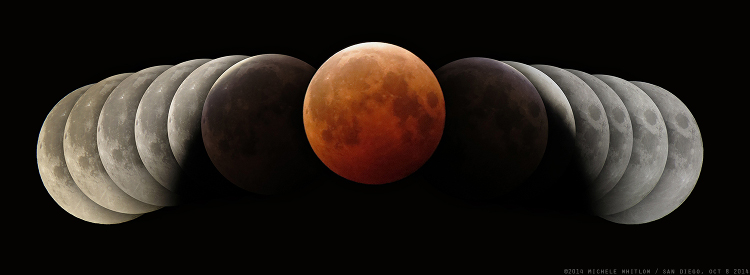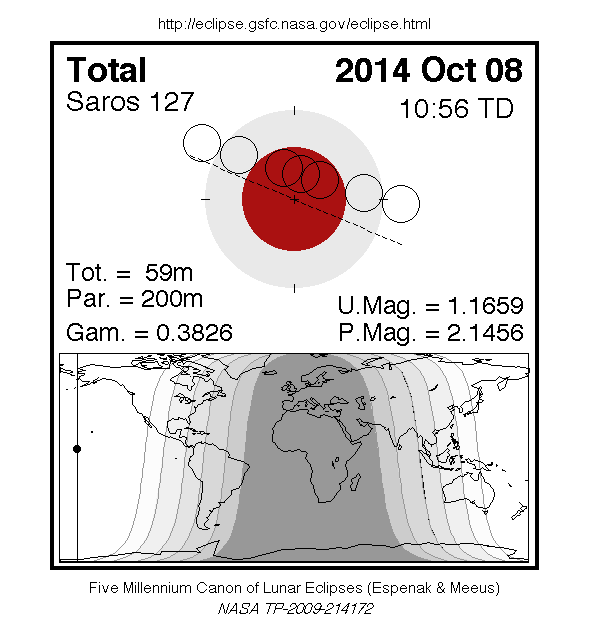A total eclipse of the Moon occurred on Wednesday 8 October, 2014 UT, lasting from 08:15–13:33 UT. A shallow total eclipse saw the Moon in relative darkness for 58 minutes and 48 seconds. The Moon was 17% of its diameter into the Earth's umbral shadow, and should have been significantly darkened for viewers from east Asia and North America, with the beginning visible from most of South America. The partial eclipse lasted for 3 hours and 20 minutes in total.
The timings of the phases of the eclipse are as
follows. You would have been able to see each phase of the
eclipse if the Moon was up at the corresponding time as
seen from your location; however the penumbral phase
would have been very difficult to see in practice:
| Penumbral eclipse began: |
08:15:36 UT |
| Partial eclipse began: |
09:14:48 UT |
| Total eclipse began: |
10:25:09 UT |
| Maximum eclipse: |
10:54:35 UT |
| Total eclipse ended: |
11:23:59 UT |
| Partial eclipse ended: |
12:34:19 UT |
| Penumbral eclipse ended: |
13:33:39 UT |
During this eclipse the Moon was just 2 days past perigee, making it fairly large.
At maximum eclipse it was 0.554° in apparent
diameter, which is 4.3% larger than average.
The statistics page has information on the ranges of the sizes of
the Sun and Moon, and the Moon data page displays detailed
information on the Moon's key dates.
Photography

The stages of the total lunar eclipse; beautifully captured by Michele Whitlow.
Viewing
In Asia, the eclipse will be visible after sunset, as the Full Moon rises. Viewers in Thailand, central China, and western Mongolia will see the Moon rise during the total eclipse; in Australia, Indonesia, and eastern China and Mongolia, the total eclipse will begin after the Moon has risen.
New Zealand, Hawaii, and others in the Pacific will have a fantastic view of the entire eclipse.
In South America, only the north-western countries will see the total eclipse, and only some of it as the Moon sets. Panama will miss the end of the total eclipse; from Nicaragua west, the whole total eclipse will be visible. In North America, only Nova Scotia will miss out completely; and west of New York / Virginia, the whole total eclipse will be visible close to dawn, as the Moon dips in the west.
Interactive Map
This map shows the visibility of the eclipse at various stages.
The bright area in the middle saw the whole eclipse; the coloured
bands to the right saw the start of the eclipse, and those on the
left saw the end. Note that the map is approximate, and if you were
near the edge of the area of visibility, the moon was very close to the
horizon and may not have been practically visible.
You can use the zoom controls to zoom in and out, and pan to
see areas of interest. Hover your mouse over the
tags to see what was visible from each area on the map. The green
marker in the centre shows where the Moon was directly
overhead at maximum eclipse.
The interactive map is currently not available.
Overview Map
This map sourced from NASA Goddard Space flight Center: GSFC Eclipse Web SiteGSFC Eclipse Web Site
The primary source of all the information on eclipses presented here at Hermit Eclipse. (NASA Goddard Space flight Center)
shows the visibility of the eclipse. (Click on it for the
full-sized version.)
Eclipse Season and Saros Series
This eclipse season contains 2 eclipses:
This was the 42nd eclipse in lunar Saros series 127.The surrounding eclipses in this Saros series are:
This Saros series, lunar Saros series 127,
is linked to solar Saros series 134. The
nearest partner eclipses in that series are:
Eclipse Parameters
| UT Date/time (max) | 10:54:35 on 8 Oct UT |
TDT Date/time (max) | 10:55:44 on 8 Oct TDT |
| Saros Series | 127 |
Number in Series | 42 |
| Penumbral Magnitiude | 2.1456 |
Central Magnitiude | 1.1659 |
| Gamma | 0.3826 |
Path Width (km) | |
| Delta T | 1m09s |
Error | ± 0m02s (95%) |
| Penumbral Duration | 5h18m |
Partial Duration | 3h20m |
| Total Duration | 58m48s |
| |
| Partial Rating | |
Total Rating | |
| Sun Distance | 149471481 km (49.2%) |
Moon Distance | 365667 km (18.4%) |
| Sun Diameter | 0.534° |
Moon Diameter | 0.544° - 0.554° |
| Perigee | 09:42 on 6 Oct UT |
Apogee | 06:06 on 18 Oct UT |
| Contact p1 | 08:15:36 on 8 Oct UT |
Contact p2 | |
| Contact u1 | 09:14:48 on 8 Oct UT |
Contact u2 | 10:25:09 on 8 Oct UT |
| Max eclipse | 10:54:35 on 8 Oct UT |
| Contact u3 | 11:23:59 on 8 Oct UT |
Contact u4 | 12:34:19 on 8 Oct UT |
| Contact p3 | |
Contact p4 | 13:33:39 on 8 Oct UT |
Note that while all dates and times on this site (except
where noted) are in UT, which is within a second of civil time,
the dates and times shown in NASA's eclipse listingsGSFC Eclipse Web Site
The primary source of all the information on eclipses presented here at Hermit Eclipse. (NASA Goddard Space flight Center)
are in the TDT timescale.
The Sun and Moon distances are shown in km, and as a
percentage of their minimum - maximum distances; hence 0%
is the closest possible (Earth's perihelion, or the
Moon's closest possible perigee) and 100% is
the farthest (aphelion, the farthest apogee).
The statistics page has information on the ranges of sizes
of the Sun and Moon, and the Moon data page displays detailed
information on the Moon's key dates.
Data last updated: 2015-06-21 22:11:46 UTC.


